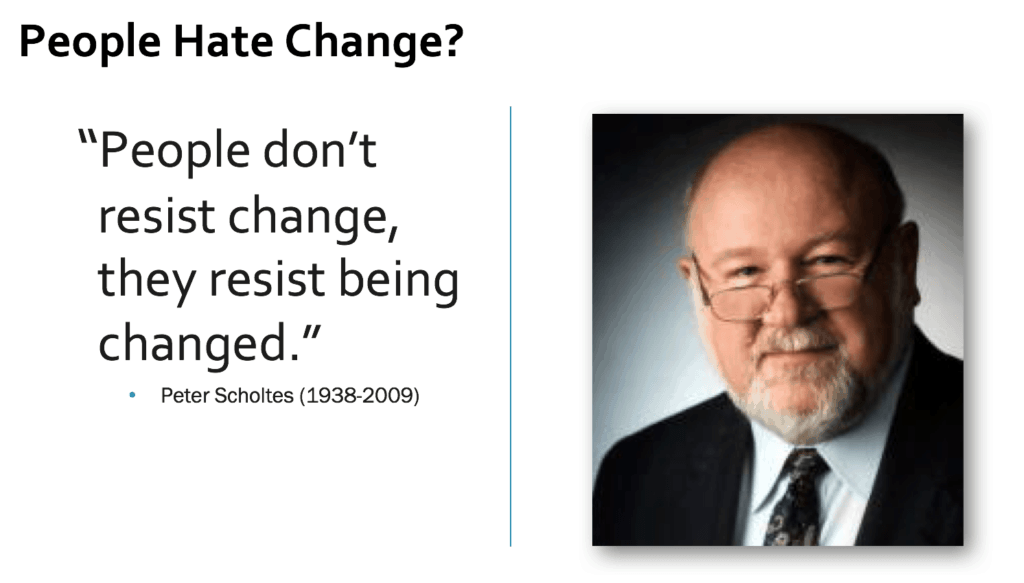When I was recently considering switching from an iPhone 6S to a newer iPhone 8 Plus (or an iPhone X), I wrote this post on LinkedIn, which I'll expand upon a bit in this post.
I ended up buying an iPhone 8 Plus, a decision I don't regret so far.
I write a lot about not labeling people as “resistant to change.” People aren't being labeled as “resistant” because we admire their critical thinking skills. It's being use as a negative, as in in “what's wrong with them, why are they resistant?”). That's a shame, since resistance is a natural and expected part of any change process (as we learn through the field of “Motivational Interviewing“). I even see very experienced Lean people (“thought leaders” even) fall into the trap of labeling or implying that people are resistant to change.
It reminds me of the quote attributed to the late Peter Scholtes and others: “People don't resist change, they resist being changed.”

Change can still be difficult, even when change is self initiated and not pushing on you by others.
When it was released, the iPhone 6 Plus seemed enormous and too big of a leap in size from the iPhone 5S that I owned. So I got the iPhone 6 during that upgrade cycle. The 6 was bigger than the 5S, but it was a smaller jump in size than going from the 5S to the 6 Plus would have been.
(These are “First World Problems,” I realize)
Incremental change is easier to accept than big leaps. That's a lesson we learn from Dr. Robert Maurer and his work on Kaizen.
Now, I'm considering an iPhone 8 Plus for a number of reasons (namely its better camera). I'm willing to consider it now because it's incrementally not that much bigger than my iPhone 6S.
There are things I might like about the upcoming, radically different iPhone X, but not having a home button and the idea of facial scanning is scary. I'm comfortable with the home button. It's what I'm used to. It works for me.
This article covers the lack of a home button and pretty much shares my view:
The iPhone X leaves a home-button-shaped hole in my heart
Am I being “resistant to change?”
It's natural to be afraid of change, right?
Would a “small test of change” (such as using the iPhone X in a store or having a 30-day return policy) alleviate some of this fear? Maybe that works for the home button issue, since I have trouble picturing how the phone works without a home button (even after seeing video online about it).
Maybe someday I'll accept that new facial-scanning technology as I somewhat hesitantly accepted the finger scanner on my iPhone 6.
Change is never instantaneous. Change is a process – even when that change is rationally a positive thing.
Beyond psychology and therapy, we can learn that from reflecting on our own behavior… and hopefully we can start thinking about others differently and being more empathetic instead of labeling them as “resistant” or “bad.”
The LinkedIn post drew a lot of comments, some of which I'll share below:
Should we replace ‘resistance to change' with ‘reactions to change'?
Maria Sauco BSN,RN,Cert Ed.,PROSCI Cert,ITIL V3
I agree! I wouldn't even justify the term by acknowledging it. Resistance in reality is just merely questions unanswered. This is when we revisit our approach in managing and engaging our stakeholders.
Well said! You nailed it when we spoke and you said there is always a root cause to the unease and we should start there.
I'm deliberate. You're cautious. He's resistant.
This is an interesting take because you've made it personal. Does knowing the fact that facial ID is substantially more secure than your fingerprint make any difference? In other words, the data clearly supports facial req as the way to go if you want better security. What makes change frustrating is when the data clearly points to a better method and for no reasonable reason there is resistance. This is when change is forced (i.e., remove the home button). You live with the short term stress – it goes away pretty quickly if the change is indeed a better way.
My reply to Greg:
Psychology teaches us that people naturally get scared by change even when it's rationally a positive thing. So I can realize that facial ID is more secure, but still be hesitant or not like it. “No reasonable reason” implies we all agree what's a reasonable reason… and the “fight or flight” instinct is primal, not reasonable. But I agree that forcing change is the worst strategy.
I have always in my long career, except when I foolishly forgot, sought out the naysayers. They are the ones that can tell you, directly or indirectly, what is wrong with your plan. Only a fool ignores these folks and labels them “resistant.” Yes, they are sometimes annoying. And they make your plan to change things harder to sell. Tough. Seek out the truth regardless of how inconvenient it is for you. Your chances of succeeding will be greatly improved.
This topic has provided very interesting insight from the user/customer's perspective. This kind of information can provide the designers with sufficient information on the expectation of the iPhone users. Mark, great topic, I just hope there is an existing platform out there where designers interact directly with iPhone users.
What do you think?
Please scroll down (or click) to post a comment. Connect with me on LinkedIn.
Let’s work together to build a culture of continuous improvement and psychological safety. If you're a leader looking to create lasting change—not just projects—I help organizations:
- Engage people at all levels in sustainable improvement
- Shift from fear of mistakes to learning from them
- Apply Lean thinking in practical, people-centered ways
Interested in coaching or a keynote talk? Let’s start a conversation.









![When Was the Last Time a Leader Around You Admitted They Were Wrong? [Poll]](https://www.leanblog.org/wp-content/uploads/2025/07/Lean-Blog-Post-Cover-Image-2025-07-01T212509.843-100x75.jpg)
This article reminded me of this post a bit… a story about a hospital standardizing on a certain mattress pad:
When someone tells me a person is resisting change, I respond that they are really giving you an opportunity to explain yourself better. It’s the silent person you have to beware.
I’d suggest that it’s, better yet, an opportunity to have a conversation, not just more one-way explaining.
I remember back, also, to when I got my first iPhone in 2009. I was concerned about switching from the BlackBerry keyboard to the iPhone glass screen typing. I was scared of change.
I did a “small test of change” by first getting an “iPod Touch,” which was far less expensive than committing to an iPhone and the service contract commitment. I learned that typing on glass would be OK.
My wife held on to using BlackBerry for a few more years (until her company made her switch). She was convinced that typing on glass would NOT be an improvement. When I tried her BlackBerry after years of typing on glass, the buttons on the BB keyboard seemed really hard to press — more effort, etc.
When she finally switched to iPhone, the transition was a struggle, but she worked through it.
I think she still misses the physical keyboard on the BlackBerry though.
I have found Rick Mauer’s framework to be helpful https://rickmaurer.com/wrm/
One other big lesson is if people do not agree that the problem is a problem then all efforts to improve will most likely be a struggle.
Some teaching and assessing understanding is needed too before attempting to improve. The more technical changes can result in lower trust that it will work if they have limited exposure/training/experience.
Would you classify the classic “We’re different” objection given to Lean as resistance?
Thanks for that link Brian. This resonates with me from his page:
That’s why I teach the change management workshop that I was able to do again yesterday. It’s not enough for an organization or leaders to have “the right answer” — we need to lay the foundation or groundwork for change.
Motivational Interviewing teaches us that “resistance” is a normal part of the change process for an individual. We need to work with people who are being “resistant” and not just steamroller them.
What I’d push back on in Maurer’s article is:
– It’s not just that people “don’t like” the change (although that’s possible). Even if a change is positive, it’s going to be scary (as Robert Maurer teaches us). Motivational Interviewing sheds insight into people “knowing” they should change, but still not taking action… people are complicated, even if they “like” the change.
– Leaders pushing a “why” on people might not be effective either. Telling somebody to make a change leads to natural pushback. Telling them why – “you should change” – might also lead to pushback (“no I don’t”). Maybe it’s better to have a conversation that allows people to discover and articulate THEIR case for change? WIIFM (What’s In It For Me) has to be internally developed, not pushed on them (not WIIFY — Whats In It For You)?
I agree that engaging people is a great strategy. This is not the same as being more persuasive or repeating one’s argument more cleverly, and it’s not about forcing people to change.
Like he said, relationships matter.
To your question about “we’re different” — that’s a form of resistance. It’s an attempt at raising an issue in a way that suggests “you should stop pushing Lean.” Telling people “no you’re not different” probably isn’t a good strategy. Instead of pushing Lean, maybe it’s more effective to find common ground on problems that people want (or need) to solve?